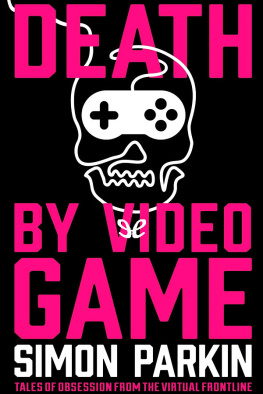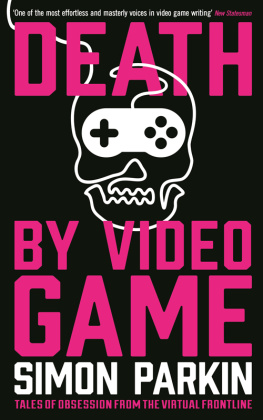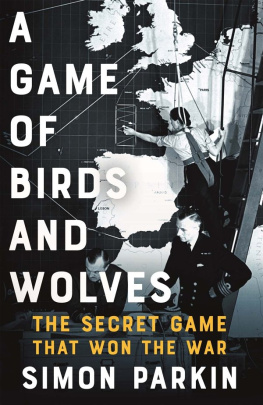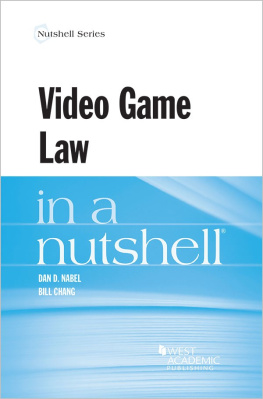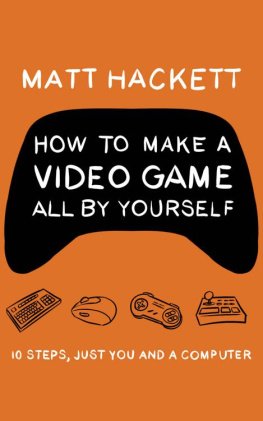Simon Parkin - Death by Video Game
Here you can read online Simon Parkin - Death by Video Game full text of the book (entire story) in english for free. Download pdf and epub, get meaning, cover and reviews about this ebook. year: 2015, publisher: ePubLibre, genre: Detective and thriller. Description of the work, (preface) as well as reviews are available. Best literature library LitArk.com created for fans of good reading and offers a wide selection of genres:
Romance novel
Science fiction
Adventure
Detective
Science
History
Home and family
Prose
Art
Politics
Computer
Non-fiction
Religion
Business
Children
Humor
Choose a favorite category and find really read worthwhile books. Enjoy immersion in the world of imagination, feel the emotions of the characters or learn something new for yourself, make an fascinating discovery.
- Book:Death by Video Game
- Author:
- Publisher:ePubLibre
- Genre:
- Year:2015
- Rating:5 / 5
- Favourites:Add to favourites
- Your mark:
- 100
- 1
- 2
- 3
- 4
- 5
Death by Video Game: summary, description and annotation
We offer to read an annotation, description, summary or preface (depends on what the author of the book "Death by Video Game" wrote himself). If you haven't found the necessary information about the book — write in the comments, we will try to find it.
Death by Video Game — read online for free the complete book (whole text) full work
Below is the text of the book, divided by pages. System saving the place of the last page read, allows you to conveniently read the book "Death by Video Game" online for free, without having to search again every time where you left off. Put a bookmark, and you can go to the page where you finished reading at any time.
Font size:
Interval:
Bookmark:
Special thanks to each of the editors with whom I have worked and from whom I have inevitably learned so much.
In particular: Nicholas Thompson, Matt Buchanan, Jay Caspian Kang, Alan Burdick and Anthony Lydgate of the New Yorker. Bobby Baird of Harpers magazine. Keith Stuart of the Guardian. Tony Mott, Joao Sanchez, Margaret Robertson and Alex Wiltshire of Edge. Tom Bramwell, Oli Welsh, Ellie Gibson and Martin Robinson of Eurogamer, Stephen Totilo of Kotaku, Chris Suellentrop of the New York Times and Matter, Kris Graft and Simon Carless of Gamasutra, Will Knight of MIT Technology Review, Greg J. Smith of HOLO and Helen Lewis of the New Statesman.
Thanks to Tom Bissell, for reading the manuscript before anyone else, for giving me an example to follow and the encouragement and belief to keep going.
Thank you, Christian Donlan, Brian Taylor, Kieron Gillen, Robert Howells, Will Porter, Ste Curran, Ann Scantlebury, Ed Hawkins and Tom Fenwick for your friendship, camaraderie and advice. To Owain Bennallack for chronoslip and for your shrewdness and encouragement.
To Steven Poole for showing us all how it should be done with such grace and elegance through the years.
To Jane Finigan, for her ever-present support and guidance, and to the team at Serpents Tail, who have worked so hard to make and chaperone this book. In particular, thank you to Nick Sheerin and Michael Bhaskar.
Thank you to my brother, with whom I first shared a joystick, to my grandmother, who bought me my first Game Boy, to my mother for her care and to my father for his lyricism. To my wife, who can still lose a day with Animal Crossing, and to my children, who each week reveal new reasons to appreciate the unique power of video games, and new reasons to be wary.

SIMON PARKIN. Simon Parkin is a contributing writer for the New Yorker, and a freelance journalist from England.
During the past decade he has been a contributor to The New York Times, Harpers, the Guardian, New Statesmen, Technology Review, BBC and a variety of other publications.
He writes a monthly column for the Observer newspaper in the UK. and the Guardian.
CHRONOSLIP
INSERT COIN TO CONTINUE
C hen Rong-Yu died in two places at once.
At 10 p.m. on Tuesday, 31 January 2012, the twenty-three-year-old took a seat in the farthest corner of an internet caf on the outskirts of New Taipei City, Taiwan. He lit a cigarette and logged into an online video game. He played almost continuously for twenty-three hours, stopping occasionally only to rest his head on the table in front of his monitor and sleep for a little while. Each time that he woke he picked up his game where hed left off. Then, one time, he did not raise his head. It was nine hours before a member of the cafs staff tried to rouse the motionless man, in order to tell him that his time was up, only to find his body stiff and cold.
Chen Rong-yu died in two places at once. Not in the sense that during those final moments his mind drifted to another place (the landscape of some comforting memory where he might be soothed or cheered, for example). Rather, when Rong-Yus heart failed, he simultaneously departed two realities.
He died there in the Taiwanese caf, with its peeling paint and cloying heat. And he died in Summoners Rift, a forest blanketed by perpetual gloom. Summoners Rift has the appearance of a remote, unvisited place, but each day it is frequented by hundreds of thousands of people, players of the online video game League of Legends, arguably the most popular online video game in the world. Summoners Rift is the pitch on which they do battle.
Rong-Yu had died here many times before. He had been speared, incinerated, or otherwise obliterated by rivals as he scrambled through its thickets and across its river in an endlessly repeating game of territorial warfare.
Many games are metaphors for warfare. The team sports football, hockey, rugby and so on are rambling battles in which attackers and defenders, led by their captains, ebb and flow up and down the field in a clash of will and power. American football is a series of frantic First World War-style scrambles for territory measured in ten-yard increments. Tennis is a pistol duel: squinting shots lined up in the glare of a high-noon sun. Running races are breakneck chases between predator and prey. Boxing doesnt even bother with the metaphor: its a plain old fistfight ending in blood and bruise.
So it is with League of Legends, a game in which two teams attempt to overwhelm one another. In warfare, real or symbolic, there are inevitable casualties. To date, Rong-Yus, deaths in the virtual forest had been symbolic and temporary, like the toppling of a pawn from a chessboard, a griefless death, easily undone. That night, however, his virtual death was mirrored in reality. It was true and final.
When the paramedics lifted Rong-Yu from his chair, his rictus hands remained in place, as if clawed atop an invisible mouse and keyboard. Like the pulp detective thriller in which the lifeless hand points towards some crucial clue, Rong-Yus final pose appeared to incriminate his killer.
Yus story is unusual, but not unique. On 13 July 2012, another young man, nineteen-year-old Chuang Cheng Feng, was found dead in his chair at a different Taiwanese internet caf. Feng, a five-foot-five tae kwon do champion, had settled down to play the online game Diablo 3 after a friend he was supposed to meet failed to show up. He played the game to pass the time: ten hours of uninterrupted questing. Then, mind hazed by the rooms thick cigarette smoke and eyes stinging from the monitors flicks and throbs, he decided to step outside for some fresh air.
Feng stood, took three steps then stumbled and collapsed, his mouth foaming. He too was pronounced dead at the scene.
There are others. In February 2011 a thirty-year-old Chinese man died at an internet caf on the outskirts of Beijing after playing an online game for three days straight. On 2 September 2012 a forty-eight-year-old man named Liu died in Kaohsiung City following a seven-hour stint at the controller. His was the third game-related death of the year recorded in Taiwan.
In 2015 the deaths came sooner. On 1 January a thirty-eight-year-old man was found dead at an internet caf in Taipei, apparently after playing video games for five days straight. A week later another: a thirty-two-year-old man, known as Hsieh, entered a caf in Kaohsiung on 6 January. Two days later employees found him slumped on the desk at which hed been playing an online game. He was pronounced dead on arrival at the hospital.
In May 2015 a man in Hefei, the largest city in the Anhui province of China, reportedly collapsed after playing a game for fourteen days straight. When the paramedics arrived, one newspaper reported him as saying, Leave me alone. Just put me back in my chair. I want to keep playing.
The deaths arent limited to South-East Asia, and they arent only contemporary.
In April 1982 an eighteen-year-old American man, Peter Burkowski, walked into Friar Tucks Game Room, a popular video-game arcade in Calumet City, Illinois. According to the arcades owner, Tom Blankly, Burkowski and a friend arrived at 8.30 p.m. and began playing Berzerk. Burkowski was a top student who hoped to become a doctor. He also had a talent for arcade games. Within fifteen minutes hed posted his initials next to two high scores on Berzerks leaderboard. Then he took four steps towards an adjacent machine, dropped a quarter into its slot, and collapsed dead from a heart attack.
Font size:
Interval:
Bookmark:
Similar books «Death by Video Game»
Look at similar books to Death by Video Game. We have selected literature similar in name and meaning in the hope of providing readers with more options to find new, interesting, not yet read works.
Discussion, reviews of the book Death by Video Game and just readers' own opinions. Leave your comments, write what you think about the work, its meaning or the main characters. Specify what exactly you liked and what you didn't like, and why you think so.

